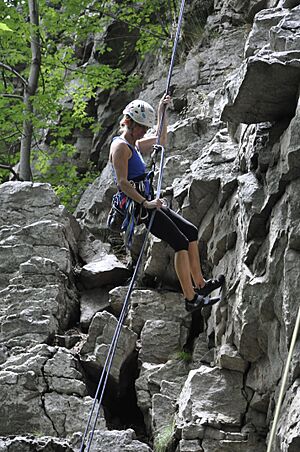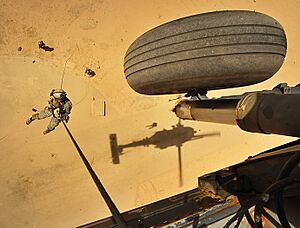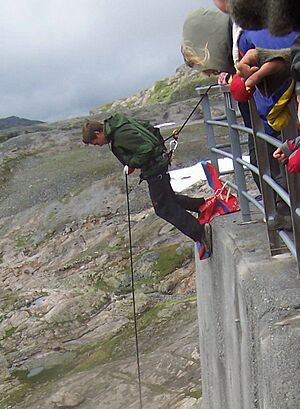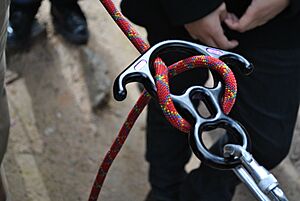Abseiling facts for kids
Abseiling (pronounced AB-sayl) or rappelling (pronounced RAP-pell) is a cool way to go down a steep slope, like a rock face or a cliff, using a rope. Imagine you're at the top of a tall wall, and you need to get down safely. Abseiling lets you control your own movement as you slide down the rope. This is different from someone else lowering you down, where they control the rope from above.
Contents
What is Abseiling?
This technique is used by many adventurers and professionals. Think of climbers, mountaineers, and cavers who explore deep caves or tall mountains. It's also used by canyoners who travel through rocky canyons, often involving waterfalls. Even search and rescue teams and special workers who fix tall buildings use abseiling to reach tricky spots. It helps them get to places that are too steep or dangerous to go down without a rope.
To go down safely, abseilers use special methods to create enough friction on the rope. This friction helps them control their speed comfortably. Some very old ways involved wrapping the rope around your body, but today, people use special tools called descenders. These tools help manage the rope easily. People choose their method based on how fast they need to go, how safe it is, and what equipment they have.
In the United States, most people say "rappelling." In the United Kingdom, both "abseiling" and "rappelling" are understood, but "abseiling" is more common. In places like Australia, New Zealand, and Canada, both words are used.
A Look Back: The History of Abseiling
People have been using ropes to go down steep places for hundreds of years! Early methods involved simple ways of wrapping ropes around the body. Special tools to help with descent were described as early as the 1600s.
The word "rappel" became popular thanks to a French guide named Jean Charlet-Straton. Around 1876, he used a technique with a doubled rope to descend from a mountain called Petit Dru in the Chamonix area. This method allowed him to pull the rope down after he was finished. While the exact technique he used might not be what we call abseiling today, his efforts helped make the idea of using ropes for descent more widely known. He successfully reached the summit of Petit Dru in 1879 with two other guides.
Essential Gear for Abseiling
To abseil safely, you need specific equipment. Each piece plays an important role:
- Ropes: Strong ropes are essential. Sometimes special "static" ropes are used, which don't stretch much.
- Anchors: These are strong points where the rope is attached at the top. They can be natural things like trees or big rocks, or special equipment like bolts fixed into the rock.
- Descender: This is a special device that creates friction on the rope. It allows you to control your speed as you go down with very little effort.
- Climbing harness: This is a special belt that fits around your waist and legs. Your descender attaches to it, keeping you secure. It's important that it fits well to keep you safe.
- Safety back-up: This is an extra safety knot or device wrapped around the rope. It acts as a brake if you accidentally lose control, stopping you from falling too fast.
- Helmets: Always wear a helmet! It protects your head from bumps and from any small rocks that might fall.
- Gloves: These protect your hands from the rope and from hitting the rock face.
- Boots or climbing shoes: These help you grip the rock better as you move down.
- Knee pads (and sometimes elbow pads): These protect your knees and elbows from scrapes.
Where is Abseiling Used?
Abseiling is used in many exciting and important situations:
- Climbing: After reaching the top of a climb, abseiling is often the safest way to get back down.
- Fun and Adventure: Many people enjoy abseiling as a thrilling outdoor activity.
- Canyoning: When exploring canyons, abseiling helps people go down tall waterfalls or steep cliffs.
- Mountaineering: It's a key skill for mountaineers to descend difficult parts of mountains.
- Caving: Explorers use abseiling to go down into deep, vertical sections of caves.
- Adventure Racing: Abseiling is often one of the challenges in these multi-sport races.
- Working at Heights: Special workers use abseiling (called "rope access") to clean windows on skyscrapers, do repairs, or perform inspections on tall structures.
- Fighting Wildfires: Firefighters sometimes abseil from helicopters to reach wildfires in remote, difficult areas.
- Rescue Missions: Rescue teams use abseiling to reach injured people on cliffs or in hard-to-reach places.
- Military Operations: Soldiers, especially special forces, use abseiling from helicopters to quickly get into areas where there's no safe place to land.
Different Ways to Abseil
There are several ways to abseil, each with its own purpose:
- Australian rappel: This is often used in military training. The person goes down facing the ground, which allows them to see where they are going and even use their hands freely.
- Tandem abseiling: This is used in rescue situations. Two people go down on the same rope and device, which is helpful if one person is hurt or needs to get down quickly.
- Simul-rappelling: Two climbers go down at the same time on the same rope. One person's weight helps balance the other. This can be faster but requires careful coordination.
- Releasable abseil: Guides use this safety technique. If a less experienced person gets stuck while abseiling, the guide can safely lower them to the ground.
- Classical methods: These are older ways of abseiling without modern devices, by wrapping the rope around the body. They are more dangerous and only used in emergencies when no other equipment is available.
- Fireman's Belay: This is a safety backup. Someone on the ground holds the rope. If the abseiler starts to fall too fast, the person on the ground can pull the rope to stop them.
Staying Safe While Abseiling
Abseiling can be exciting, but it's very important to be safe. It can be dangerous if not done correctly or without proper training and supervision. Many accidents happen because the anchors (where the rope is attached) are not set up properly, or because people don't use their safety backups correctly. Always make sure your equipment is in good condition and that you understand how to use it. Learning from experienced instructors is the best way to stay safe.
Protecting Nature While Abseiling
Sometimes, abseiling for fun is not allowed in certain areas. This is because it can accidentally damage the environment, like plants or rocks. It can also get in the way of other climbers who are trying to go up, or even put people on the ground at risk from falling rocks or equipment. It's important to always follow rules and guidelines in natural areas to protect them for everyone.
See also
- Canyoning
- Caving
- Mountaineering
- Search and rescue
- Fast-roping





